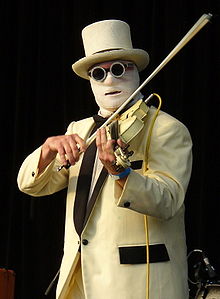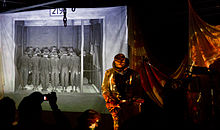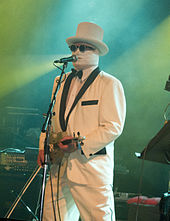- Nash the Slash
-
Nash the Slash 
Nash the Slash in concert in July 2008Background information Birth name Jeff Plewman Born 26 March 1948 Origin Toronto, Ontario, Canada Genres Progressive rock, electronic Instruments Electric mandolin, electric violin, keyboards, synthesizer, glockenspiel Years active 1975–present Labels Cut-throat, Dindisc, Virgin, Quality, PVC, Ralph Associated acts Gary Numan, FM Website www.nashtheslash.com Nash the Slash (born Jeff Plewman on 26 March 1948) is a Canadian musician. Though a multi-instrumentalist, he is known primarily for playing electric violin and mandolin, as well as harmonica, keyboards, glockenspiel, and other instruments (sometimes described as "devices" on album notes).[citation needed]
Nash worked as a solo artist beginning in 1975, then founded the progressive rock band FM in 1976. After it recorded one album, he left in 1977 to resume his solo career, which he relaunched in February 1978. (It was not until after Nash's departure that the album became widely issued and promoted, eventually charting and receiving a gold record award.[citation needed]) He later rejoined FM from 1983 to 1996, concurrent with his solo work which continues to the present day.
Nash's music covers a wide range, varying from instrumental mood-setting music to rock and pop music with vocals. In addition to giving concert performances, he has composed and performed soundtrack music for silent films, presenting these works live in movie theatres to accompany screenings of the films. Another venue for his music is in performances to accompany the viewing of paintings by surrealist painter Robert Vanderhorst, an audiovisual collaboration which took place in 1978, and again in 2004.
Contents
Identity
Since 1979 Nash has always performed with surgical bandages covering his face. "During a gig at The Edge in the late '70s to raise awareness of the threat from the Three Mile Island disaster, he walked on stage wearing bandages dipped in phosphorus paint and exclaimed: "look, this is what happens to you". The bandages became his trademark."[1][2] Prior to 1979, Nash performed three times on TV Ontario's Nightmusic Concert, first as a solo artist (a live broadcast which was never re-aired), then with FM (Nash and Cameron Hawkins), then again as a solo artist. In all of these appearances Nash wore his typical black tuxedo, top hat, and dark sunglasses, but wore no bandages.
Born Jeff Plewman (as given in copyright depositions at the Library of Congress),[3][4] he has attempted to keep his true identity the subject of some speculation. In a 1981 interview with the UK magazine Smash Hits, Nash's response to a question about his real name was "Nashville Thebodiah Slasher".[citation needed] By never officially confirming or denying his name, some fans came to believe Nash to be an alter ego of Ben Mink, who replaced him as FM's violinist in 1978. This is a common misconception but he has been photographed onstage with Ben Mink.[5]
Career
Nash's music is a complex blend of new wave, new age and punk rock, using electric mandolins, violins, drums machines and an arsenal of effects and sonic devices. He has written, played and produced most of the material on his solo albums by himself, although he has also worked with producers Daniel Lanois and Bill Nelson.
Nash has been creating his unique concept of sound and vision for over thirty years. His persona was born of silent film. The name comes from a killer butler encountered by Laurel and Hardy in their first film Do Detectives Think? (1927), for which he has composed a soundtrack score.[citation needed]
First group
Before working as a solo artist, Nash recorded an unreleased song called "Slasher" with a group called Breathless which also included his (and FM's) future producer, Michael Waite on bass guitar. The song appeared on a various artists promotional album titled Concept (after the Toronto based management company, Concept 376; this was one of a series of such albums), but was not issued to the public in any form. The promo album does not list the group's personnel, or even a songwriting credit, but Nash is clearly heard singing a song which begins with "Hear the children of the night" (although it is a completely different song from his later work, "Children of the Night"), and playing electric violin. The song also has a complex organ solo which is not in Nash's usual style (nor that of Cameron Hawkins of FM), and was almost certainly played by someone else. Other instruments include electric guitars and drums.
First solo career and film work
Nash's first solo performance, and his first live presentation of music to film, occurred when he played his soundtrack to Luis Buñuel's surreal silent film Un chien andalou (1929) at the Roxy Theatre in Toronto on March 17, 1975.[6]
Silent film composition
He also composed music for other classic silent films including Nosferatu (1922) and The Cabinet of Dr. Caligari (1920). When performing soundtracks, Nash appears on stage beside the screen (using his own projection screen when a full theatre screen is not available), the same format he uses when performing concerts. He has also composed scores for modern Canadian films Roadkill (1990) and Highway 61 (1991), both directed by Bruce McDonald. His other movie score and soundtrack work has included The Kidnapping of the President (1980), Black Pearls (1989), and Blood and Donuts (1995).
During this time, Nash appeared on record for the first time on David Pritchard's solo album Nocturnal Earthworm Stew (1976) with a short solo track titled "Nash Metropolitan", and on an improvised piece with Pritchard and drummer Martin Deller, with whom he would later work with in FM. He also appeared on the live TV-Ontario program Nightmusic (before it changed format and became Nightmusic Concert); in this incarnation the show was a televised version of an FM radio show hosted by disc jockey Rainer Schwartz, and had not featured a live performer before. Nash claims he was both the first and last musical artist to appear on the show.
Work with FM
After working as a solo artist for a year, Nash formed the group FM in 1976, initially as a duo with Cameron Hawkins, and later added a third member, Martin Deller on drums. The group began recording in July 1976, although no performances in its duo format were issued at the time, but they did appear on television and in live concerts beginning November 1976. In 1977, with Deller added to the group, they recorded the album Black Noise which received a gold record award. By the end of 1977, Nash had left FM, and resumed his solo career starting with another television appearance on Nightmusic Concert on February 28, 1978.[6] Nash rejoined FM from 1983 to 1989, and again from 1994 to 1996. During these years, he recorded a further three albums with the group. FM also recorded three albums during Nash's absence (1977 to 1980), with Ben Mink as his replacement.
Late 1970s and 1980
Nash had intended to restart his solo career in 1978 with a new album featuring all the music from his Nightmusic Concert TV special, plus his soundtrack for Un chien andalou, but found the sound quality of a test pressing to be unsatisfactory, so he issued a four song 12-inch EP titled Bedside Companion instead, on his own label, Cut-throat Records, which he continues to operate to the present day. A full album, Dreams and Nightmares with the rest of the Nightmusic material, the soundtrack, and a few new songs, appeared the following year. All music from these records was instrumental, and both are now available on one CD titled Blind Windows which also includes the 45 rpm EP playing at 33 rpm as the "Marsden versions", a joking reference to disc jockey David Marsden who mistakenly played the entire record at the wrong speed on radio when it was released.
Also in 1979, Nash thanked Toronto radio station CFNY for their support of his music by playing electric violins on the station's theme song recorded by various disc jockeys of the station, a strange blend of new wave and country music (with Nash's solo being in neither style). It was released as "Working on the Radio" by the 102.1 Band, as a single on Ready Records. The B-side has an extended version with a longer solo by Nash, who is not credited on the cover.
Nash's solo career up to this point had only a small cult following, due to his working exclusively as an instrumentalist. His next record, a 1980 single featuring a cover version of Jan and Dean's "Dead Man's Curve" with vocals, propelled him to greater public recognition. The B-side, "Swing Shift (Souixante-Neuf)" also featured vocals, and was co-composed with lyricist Toby Dammit, with whom Nash further collaborated over the next few years. Music videos were made for both songs.
Nash also played on three songs by Toronto group Drastic Measures for their self titled album, including violins on their signature tune, a cover version of the children's song, "The Teddy Bears' Picnic". Nash's label, Cut-throat Records, later issued a single by the group, the only other artist to appear on his label, although Nash was not involved in its recording. Nash's later soundtrack album for Highway 61 includes tracks by Tony Malone, the lead singer for Drastic Measures.
Nash was invited by Gary Numan to tour the UK as his support act in 1980 and 1981, and also toured Europe with The Tubes. He was signed to the Dindisc Records label and in 1981 he released the album Children of the Night in Europe, also released in Canada shortly after. Several British singles were also issued. These records appeared on the Dindisc / Cut-throat label in Europe, and on Virgin / Dindisc / Cut-throat in Canada.
Mid 1980s
Returning to Toronto in spring 1981, Nash released an instrumental "mini-album" Decomposing (1981) which purported to be playable at any speed, with song timings on the label quoting three lengths, depending on whether the record is played at 33, 45, or 78 rpm. However, songs from this record also appeared on compilation albums and singles, where they always play as heard when Decomposing is played at 45 rpm. This remains Nash's only significant release that has yet to be reissued on CD.
Nash's next album was And You Thought You Were Normal (1982). This included the track "Dance After Curfew" produced by Daniel Lanois prior to his association with Brian Eno. The single became a surprise club and radio hit in Poland, which was then still behind the iron curtain, where curfews and restrictions on western culture were imposed by the government of the time. A 12-inch single featuring a remixed and extended version of the song was issued in the USA on PVC Records.
Nash's next project was an album of American rock classics titled American Band-ages. Nash enlisted the help of his former FM collaborators Cameron Hawkins (keyboards) and Martin Deller (drums), and the album was released in 1984. The album was aimed at the US market, but due to distribution and management problems, including a change in record labels (to MCA, after Quality Records folded in 1985), it never got the exposure Nash thought it deserved. In the same year, Nash released a compilation album (with most tracks remixed) titled The Million Year Picnic on Ralph Records in the USA, the label which was home to The Residents.
While working on American Band-ages in 1983, Nash proposed to promote it with a double bill tour with his former band FM. But Ben Mink, Nash's replacement, had left the band that year; therefore Nash rejoined the group, staying with them from 1983 to 1989 (followed by a reunion tour from 1994 to 1996), and retaining the idea of a double bill by performing solo as the opening act. With Nash, FM released further albums: Con-Test (1985), Tonight (1987), and RetroActive (1995).
1990–present
After the break-up of FM in 1989, Nash embarked on a series of film soundtrack projects, and revived his Cut-throat label in 1991 to issue these on CD, and has also used it to re-issue his earlier records. New albums of songs with vocals have also been released on the label: Thrash (1999) and In-A-Gadda-Da-Nash (2008), the latter consisting entirely of cover versions.
In 1998, Nash the Slash performed as part of Toronto's Pride Week, publicly acknowledging that he was gay.[2]
During 2004 and 2005 Nash was again working with Robert Vanderhorst, under the name Two Artists, on the project View From the Gallery,[7] a live multimedia event presenting a fusion of surrealistic visuals with classic stylings in music.
Nash has appeared as a character in several comic books by Matt Howarth. Nash has also provided original music on a CD for Howarth's graphic novel The Simultaneous Man.
You can see Nash's image in a couple of murals painted by artist, Jungle Ling in Toronto, Canada located in the Leslieville district. Beside a TD bank at Queen St. East and Logan Ave. and below Queen St. E. on Cannaught Ave., a neighbourhood beautification project conducted by the Toronto Transit Commission. He is considered a local hero by many[by whom?] of the artists who reside in his hometown.
To the present day, Nash continues to tour, mostly in his native Ontario, but occasionally elsewhere, including a late 2008 tour of the UK which resulted in a live CD.
Discography
 Nash the Slash performing his typical solo stage show. The visual behind him accompanying the song is from the classic silent movie Metropolis
Nash the Slash performing his typical solo stage show. The visual behind him accompanying the song is from the classic silent movie Metropolis See also: Cut-throat Records
See also: Cut-throat Records- Bedside Companion (EP, 1978)
- Dreams & Nightmares (1979, re-issued on CD together with Bedside Companion as Blind Windows in 1997)
- Hammersmith Holocaust (1980) {EP, live in London, 300 copies made}
- Children of the Night (1981, reissued on CD in 2000 with bonus tracks)
- Decomposing (1981, mini-album playable at any speed)
- And You Thought You Were Normal (1982, reissued on CD in 2000 with bonus tracks)
- The Million Year Picnic (1984, compilation)
- American Band-ages (1984, reissued on CD in 2003 with bonus tracks)
- Highway 61 (1991, soundtrack)
- Thrash (1999)
- Nosferatu (2000, soundtrack)
- Lost in Space (2001, by Nash the Slash, Cameron Hawkins and Martin Deller; actually a CD by FM but avoiding the name)
- In-A-Gadda-Da-Nash (2008)
- Live in London 2008 (2009)
Film soundtracks
In addition to the soundtrack albums above, Nash has composed the film scores for several movies, including:
- The Kidnapping of the President (1980) - Nash provided electronic sound effects
- A Trip Around Lake Ontario (1984, short subject)
- Roadkill (1989)
- Black Pearls (1989)
- Blood & Donuts (1995)
Excerpts from tracks on the FM album Tonight, co-written by Nash the Slash, appear in the movie Friday the 13th Part VII: The New Blood.
Movie/Video appearances
Nash has a cameo appearance in the 1989 film Roadkill, playing his own composition "We Will Be The Leaders".
He also has a cameo in the Spoons video "Tell No Lies" (1984).
DVDs
As 'Two Artists' , a collaboration with artist Robert Vanderhorst:
- View From the Gallery - One, (2004)
- View From the Gallery - Two, (2005)
Nash also released some live performances on video tape, which are out of print.
References
- ^ Canadian Pop Encyclopedia
- ^ a b Davey, Steven (1998-06-25). "Nash the Slash revels in hidden identity". nowtoronto.com. http://www.nowtoronto.com/archive/view_issue.cfm?issue=2663&page=59&keywords=nash. Retrieved 1 May 2011.
- ^ Info at Gary Numan website
- ^ Canadian Encyclopedia
- ^ Link to photo of Nash and Ben Mink
- ^ a b Dates from Dreams and Nightmares innersleeve notes.
- ^ Two Artists
External links
Categories:- 1948 births
- Living people
- Canadian male singers
- Canadian rock guitarists
- Canadian rock singers
- Canadian rock violinists
- Canadian mandolinists
- Musicians from Toronto
- LGBT musicians from Canada
Wikimedia Foundation. 2010.

